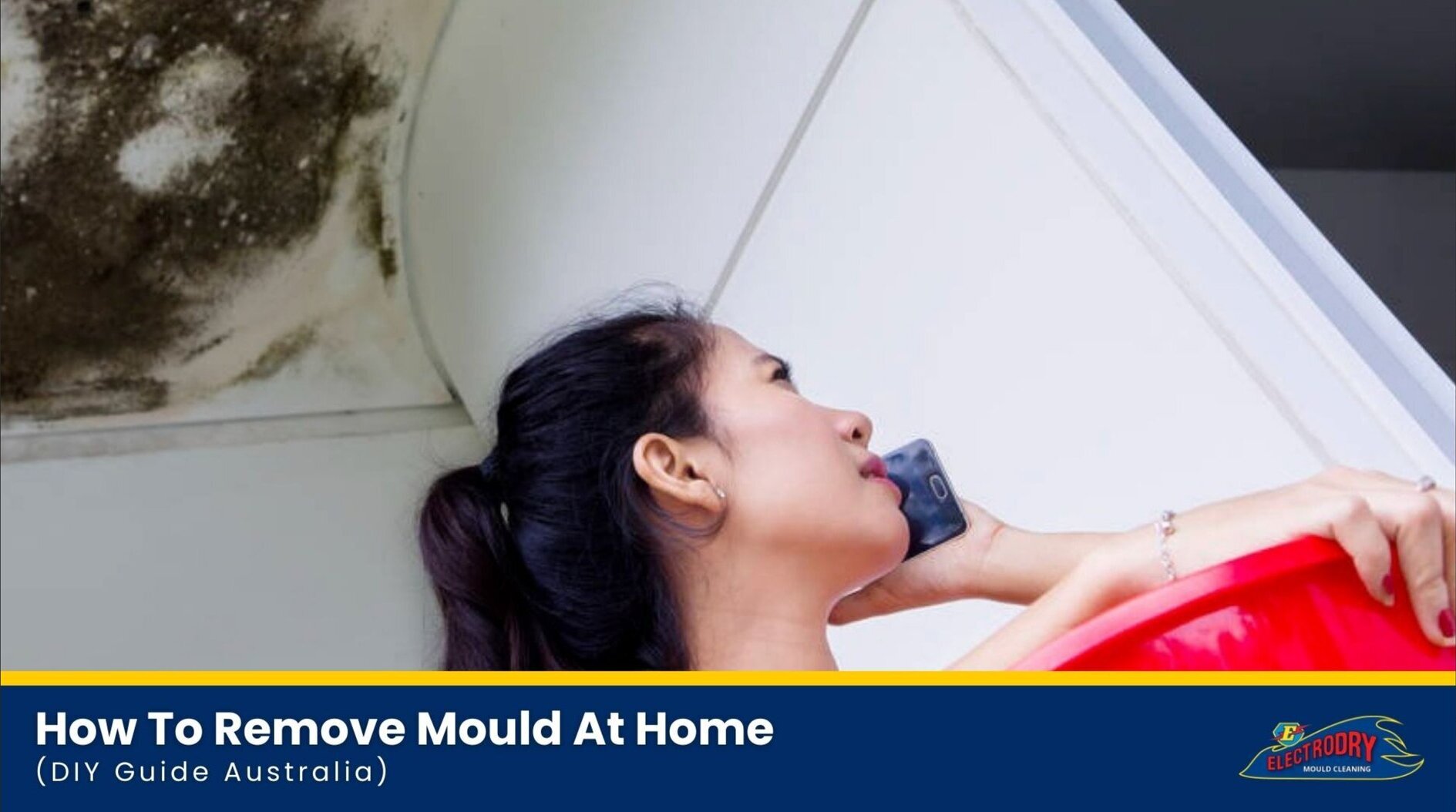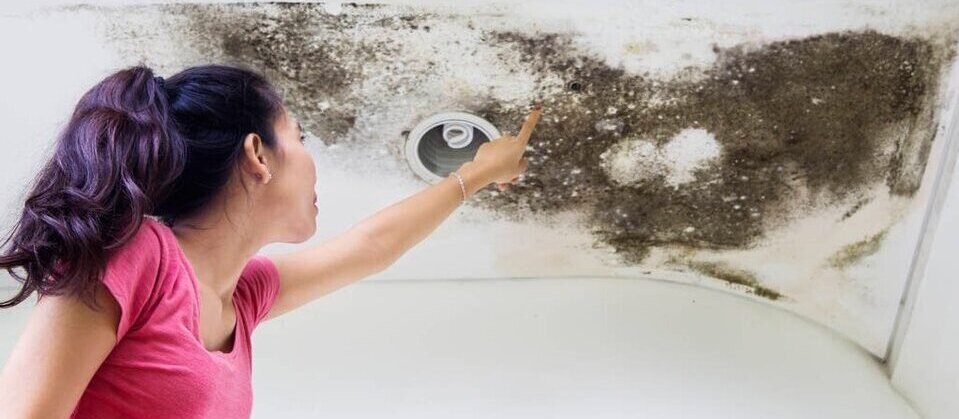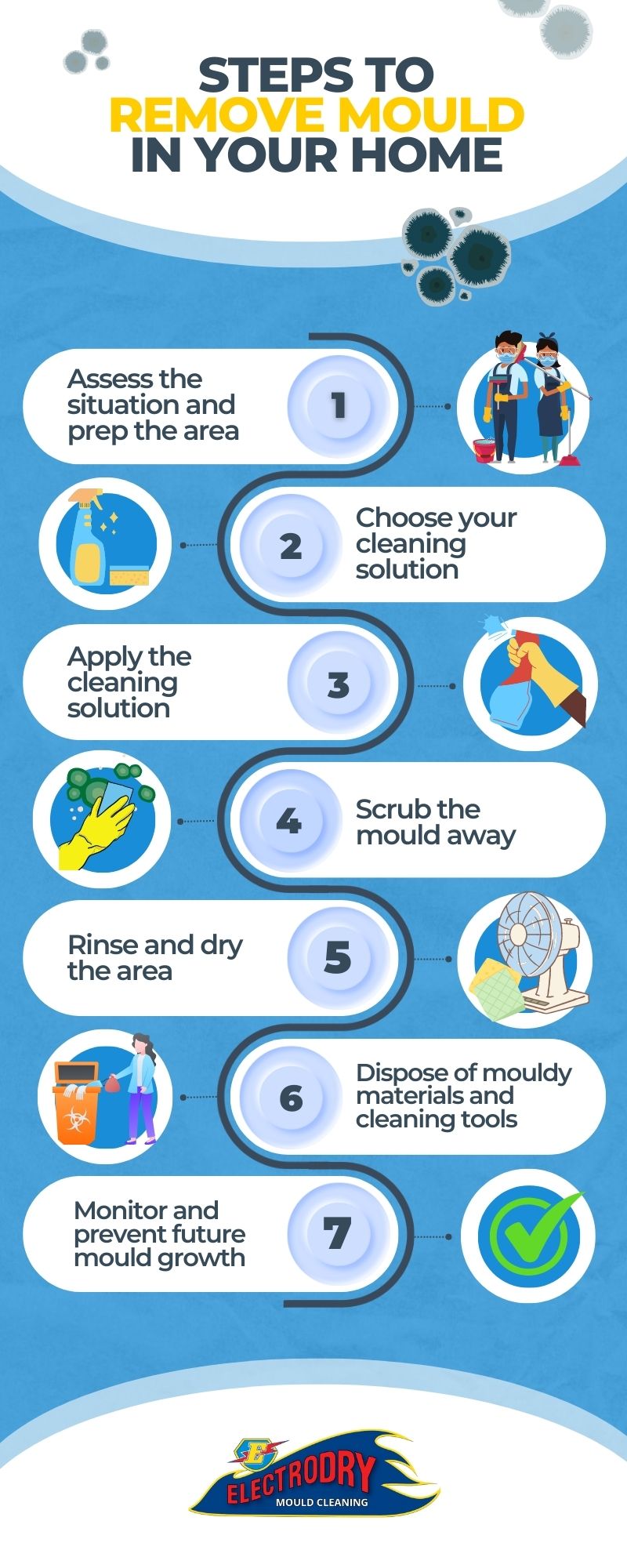How to Remove Mould at Home (DIY Guide Australia)

Mould is a common problem that many homeowners face in Australia. Not only is it unsightly, but it can also cause health problems if left untreated.
Fortunately, there are steps that you can take to remove mould around your home. In this article, we’ll provide you with everything you need to know in our step-by-step guide on how to effectively get rid of mould in your home while providing tips on prevention and protection.
If your mould problem is severe, you should consider a professional mould cleaning service, such as Absolute Mould Removal’s mould cleaning in Brisbane.
Items You Need to Remove Mould
Before tackling a mould removal project, gather the necessary tools and personal protective equipment (PPE) to ensure your safety and maintain a clean work environment. Here is an overview of the essential items you’ll need for mould removal.| Safety gear | Wear a face mask (preferably N95), safety goggles, and rubber gloves to protect yourself from mould spores. |
| Cleaning solution | Choose a mould-cleaning solution. Your choice will depend on the severity of the mould growth and the surface to be treated. A professional mould-cleaning product may be necessary for stubborn fungus, but it’s a good idea to try natural remedies first. |
| Spray bottle | Fill a spray bottle with your chosen cleaning solution to apply the solution to the area during cleaning. |
| Scrubbing tools | Use a stiff-bristled brush, microfibre cloth, or an old toothbrush for small areas of mould. A scrubbing sponge can be handy for textured surfaces or for removing mould from porous surfaces and materials. |
| Plastic sheeting | Use plastic sheeting to cover large areas or furniture to prevent cross-contamination and protect unaffected areas from the cleaning solution. |
| Fans/dehumidifiers | Proper ventilation and reducing moisture in the space are both crucial for mould prevention. Use fans and dehumidifiers during and after treatment to help dry the area. |
| Garbage bags | Have sturdy garbage bags on hand to dispose of mouldy materials, cleaning cloths, and disposable PPE. |
Mould Removal Products
| Natural Options | Professional Products |
| Borax | Concrobium Mould Control Spray |
| Vinegar | Ajax Professional Mould Remover |
| Bicarbonate of soda / baking soda | Selleys Rapid Mould Killer |
| Tea tree oil |
Steps to Get Rid of Mould in Your Home
-
Assess the situation and prep the area
- Determine the extent of mould growth and inspect the area for potential moisture problems, such as leaks or high humidity.
- Before you start cleaning, remember to put on your safety gear and prepare your workspace. Cover large items and furniture or move them out of the area if possible.
- Be careful when moving any mouldy items – this may release spores into the air.
- Make sure the area has proper ventilation. Open the windows and use a fan to air out the space as needed.
-
Choose your cleaning solution
Your choice of cleaning solution will depend on the severity of the mould problem and the surface that needs to be treated. Any of the following options can help to get rid of mould permanently.- Natural options: Use undiluted white vinegar, one teaspoon of bicarb mixed with ± 300 ml water, a tablespoon of borax mixed with a cup of water, or 5 ml of tea tree oil mixed with a cup of water.
- Professional/commercial products: Use concentrated hydrogen peroxide or a professional mould-cleaning product. Follow the instructions carefully and note any warnings. It is especially important to keep these detergents away from your eyes and skin, as well as any unsuitable/perishable materials and/or surfaces. Popular professional products include Concrobium Mould Control Spray, Ajax Professional Mould Remover, and Selleys Rapid Mould Killer.
-
Apply the cleaning solution
- Apply your chosen cleaning solution to the affected area by spraying or gently dabbing it with a cloth.
- Let the solution sit on the area to penetrate and kill the mould. The time that each solution needs to work will vary depending on what you’re using; for example, vinegar and tea tree oil need to sit for an hour to work into the mould, but hydrogen peroxide, bicarb, and professional cleaning products usually need between 3 and 5 minutes. Read product labels carefully and follow the instructions.
- Take care not to saturate the surface, as excess moisture could worsen the mould problem.
-
Scrub the mould away
Using a stiff-bristled brush or scrubbing sponge, gently scrub the mould in a circular motion, taking care not to damage the surface. Remember to frequently rinse your scrubbing tools in clean water to avoid spreading spores. You may need to apply and scrub again if the mould is still visible. -
Rinse and dry the area
After scrubbing away the visible mould, thoroughly rinse the area with clean, plain water. You can use a cloth or sponge to wipe the surface, removing excess water and residue. Use fans or dehumidifiers to fully dry the area and prevent mould regrowth. -
Dispose of mouldy materials and cleaning tools
Place mouldy materials, cleaning cloths, and disposable PPE into garbage bags, securely sealing them to prevent cross-contamination. Dispose of the bags according to your local waste guidelines. -
Monitor and prevent future mould growth
Regularly inspect the treated area for signs of regrowth and address any moisture, humidity, poor ventilation, or regrowth issues as soon as possible. Keeping your home clean and dry is key for preventing future indoor mould problems.
Tips for Mould Removal and Prevention

- Consider replacing porous materials, as carpet and drywall may need to be thrown out. These items can be challenging to clean completely, so the mould may return.
- Use vinegar first. The removal of mould with vinegar is a very simple solution and a common first line of defence, as vinegar kills mould naturally and it’s cheap.
- Tea tree oil has natural anti-fungal properties and can be used as a natural alternative for mould removal.
- Avoid using a vacuum cleaner to remove mould. This may spread the spores throughout the room or damage your vacuum cleaner.
- Check any areas where mould is likely to grow and remove mould as soon as possible to prevent mould from returning. Indoors, mould and mildew often grow in poorly ventilated areas, such as bathrooms, kitchens, wardrobes, washing machines, and basements. Mould has also been regularly found on wicker baskets and soft furnishings such as curtains and pillows, so be sure to check these as well.
- Mould loves damp areas, so check for roof and plumbing leaks, condensation on and around windows and walls, and burst pipes. Clean mould after flooding or water damage as soon as possible to prevent mould regrowth. Also check for discolouration, which can be evidence of mould on walls. Check likely areas for a musty smell, as this can indicate mould growing in your home.
- Lower indoor humidity levels. Mould will grow when the humidity level is above 70%, so make sure the air stays fresh and clean, keep windows open whenever possible, avoid steam cleaning, dry your clothes outside, and use extractor fans whenever you can. Air conditioners and dehumidifiers will also help to lower indoor humidity levels.
Mould Removal FAQs
How do you remove mould from painted walls?
You can follow the instructions and steps above to remove mould from painted walls. Do not paint over mould as this will not resolve the issue. Always remove the mould growth before repainting. You can also have a look at our step-by-step guide on how to clean mould off walls.
What’s the best home remedy to remove mould?
Often, the best and easiest method is to use white vinegar. Remember, do not mix cleaning agents, as harmful gases and acids may be produced. For example, mixing hydrogen peroxide and vinegar will produce a dangerous, corrosive acid called peracetic acid.
Is bleach or vinegar better to kill mould?
Vinegar. Avoid using bleach. Not only is bleach toxic, but it doesn’t actually kill mould or fungus. You may find bleach listed as a cleaning hack for killing mould on non-porous surfaces, but it only makes the mould lighter and removes the colour. Bleached mould will grow back. Follow our guide above or read more about how to use vinegar.

